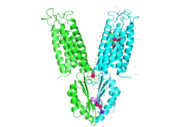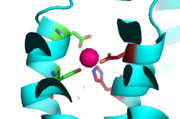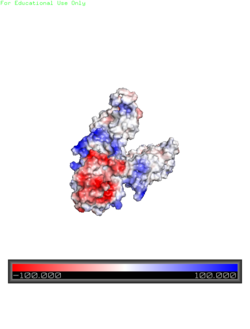Sandbox Reserved 1069
From Proteopedia
| Line 5: | Line 5: | ||
==Structure== | ==Structure== | ||
<StructureSection load='3h90' size='340' side='right' caption='Zinc Transporter YiiP' scene=''> | <StructureSection load='3h90' size='340' side='right' caption='Zinc Transporter YiiP' scene=''> | ||
| - | YiiP is a homodimer with transmembrane (TMD) and C-terminal (CTD) domains that are connected via a charge interlocking mechanism located on a flexible loop. There are 3 Zn<sup>2+</sup> binding sites per unit of homodimer. Site A is located in the TMD, site C is located in the CTD, and site B is located at the junction of the domains join. Both TMD are composed of 6 helices, 4 of which (TM1,TM2,TM4,TM5) form a pore in which Zn<sup>2+</sup> and H<sup>+</sup> can reach binding Site A. Zn<sup>2+</sup> binding at site C helps hold the CTD together and is thought to stabilize conformational changes in YiiP. | + | YiiP is a homodimer [https://en.wikipedia.org/wiki/Protein_dimer protein dimer] with transmembrane (TMD) and C-terminal (CTD) domains that are connected via a charge interlocking mechanism located on a flexible loop. There are 3 Zn<sup>2+</sup> binding sites per unit of homodimer. Site A is located in the TMD, site C is located in the CTD, and site B is located at the junction of the domains join. Both TMD are composed of 6 helices, 4 of which (TM1,TM2,TM4,TM5) form a pore in which Zn<sup>2+</sup> and H<sup>+</sup> can reach binding Site A. Zn<sup>2+</sup> binding at site C helps hold the CTD together and is thought to stabilize conformational changes in YiiP. |
Yiip's complete protein structure is identified as a dimer. Each monomer structure is classified into two different domains, the Trans-Membrane Domain (TMD) and C-Terminus Domain (CTD). The TMD consists of six helices, forming binding site A, four of which are oriented in a parallel manner, with respect to each other, while the remaining two are aligned anti parallel to this four helix cluster. A "<scene name='69/694234/Bridge/1'>salt bridge</scene>" or "charge interlock" consisting of four amino acid residues, two Lysines (Lys 77) and two Aspartates (Asp 207), forms a junction that both monomers of Yiip converge at, forming a pivot point for conformation changes. A large portion of the protein containing binding site C, approximately 30 Å in length<sup>[1]</sup>, protrudes into the cytoplasm functioning as a zinc sensor within the cell. | Yiip's complete protein structure is identified as a dimer. Each monomer structure is classified into two different domains, the Trans-Membrane Domain (TMD) and C-Terminus Domain (CTD). The TMD consists of six helices, forming binding site A, four of which are oriented in a parallel manner, with respect to each other, while the remaining two are aligned anti parallel to this four helix cluster. A "<scene name='69/694234/Bridge/1'>salt bridge</scene>" or "charge interlock" consisting of four amino acid residues, two Lysines (Lys 77) and two Aspartates (Asp 207), forms a junction that both monomers of Yiip converge at, forming a pivot point for conformation changes. A large portion of the protein containing binding site C, approximately 30 Å in length<sup>[1]</sup>, protrudes into the cytoplasm functioning as a zinc sensor within the cell. | ||
Revision as of 20:57, 29 March 2017
Introduction
Zinc transporter YiiP is an integral membrane protein found in the membrane of Esherichia coli. YiiP is a member of the cation diffusion facilitator family (LINK). Members of this family occur all throughout the biological realm. These diffusion facilitators export divalent transition metal ions from the cytoplasm to the extracellular space [1]. They work to regulate the amount of divalent metals inside of the cell, which is biologically relevant because while these metals are necessary for different biological functions, they can prove fatal to the cell in excess amounts. Zinc is essential for the growth and development of cells and zinc levels can affect everything from gene expression to immune response. Zinc transporters help keep homeostatic balance of zinc in cells and excessive zinc concentrations have been noted in cases of high beta-amyloid deposition contributing to Alzheimer's disease (CITE: http://science.sciencemag.org/content/317/5845/1746.full While YiiP is an integral membrane protein in the cells of Escherichia coli, understanding the mechanism of regulation behind it can help researcher's better understand the cation diffusion facilitator equivalents in eukaryotic cells.
Structure
| |||||||||||




